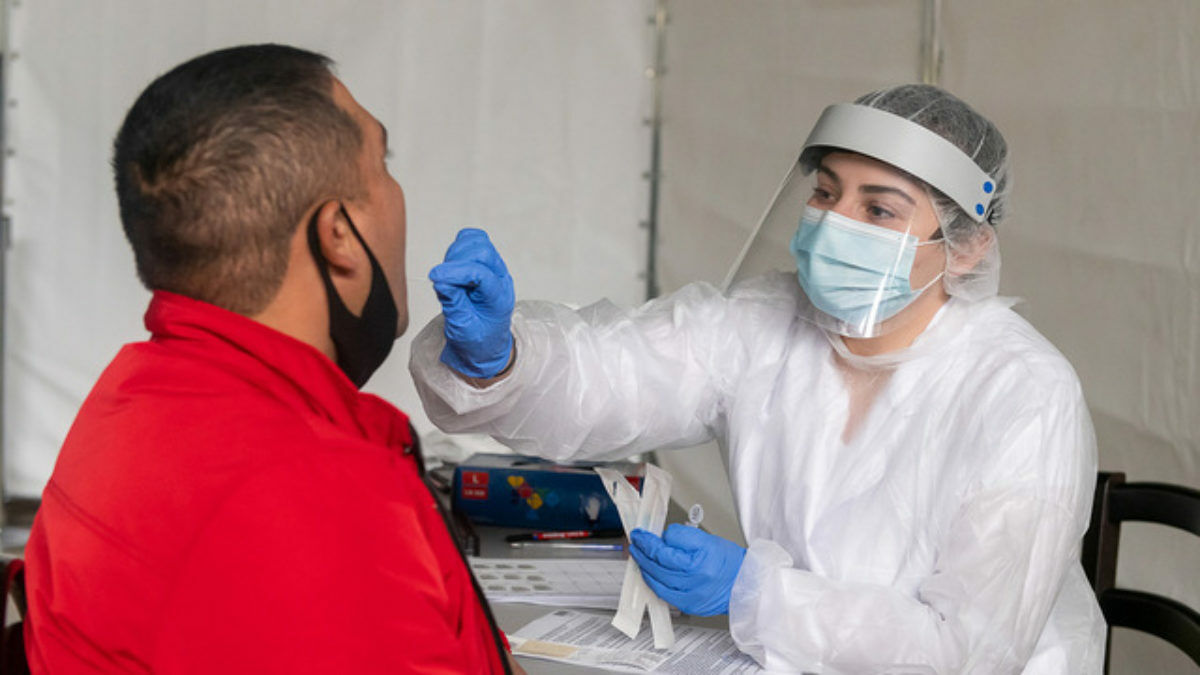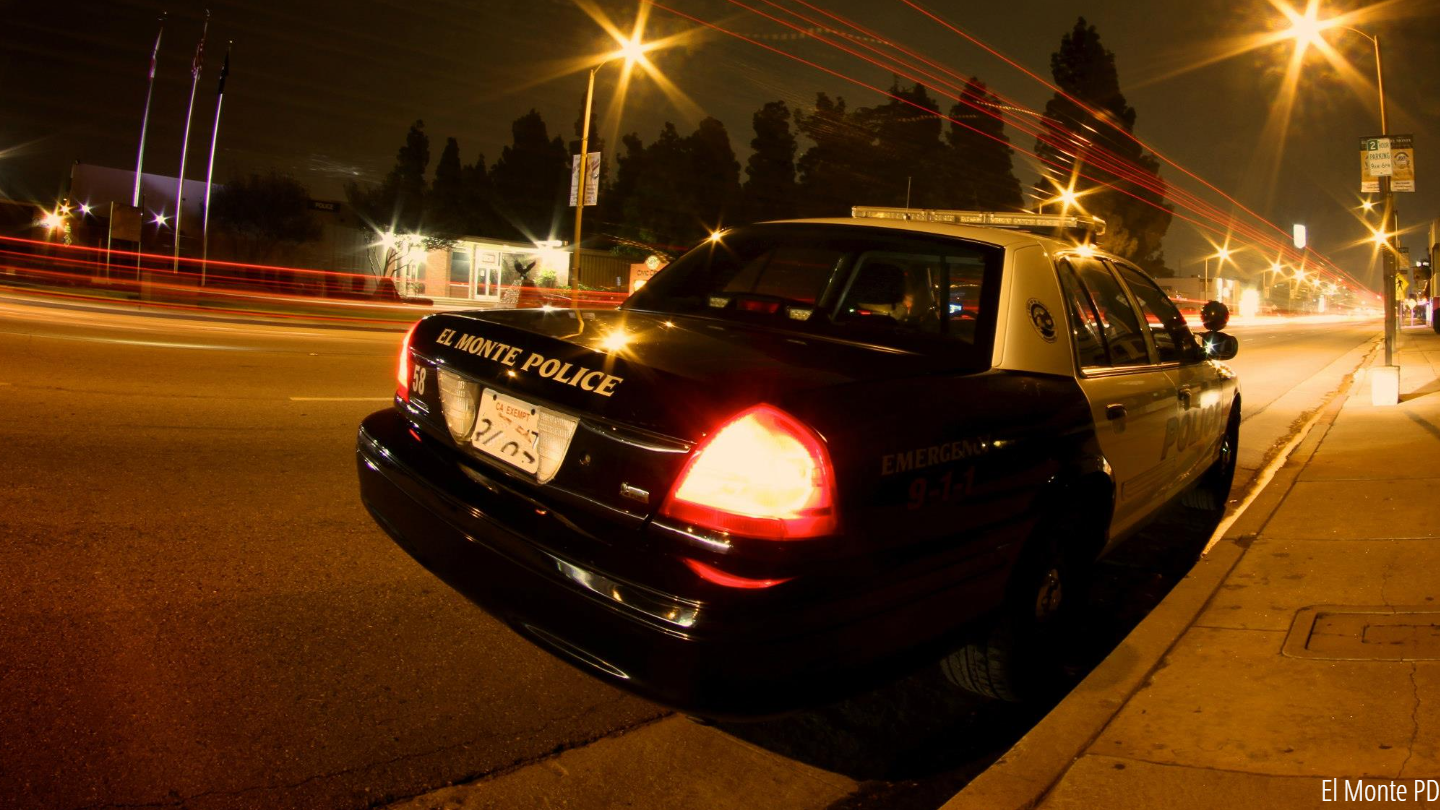A powerful storm system slammed the Southland on Tuesday with heavy rain, high winds and mountain snow, leading to flooded roadways, dangerous driving conditions and even some evacuation in Orange County due to concerns about mud and debris flows.
By early afternoon, more than 2 inches of rain had fallen in downtown Los Angeles, more than doubling the record for the date set in 1888, according to the National Weather Service. And more rain was expected to fall as the day went on.
More than 2 inches also fell in Beverly Hills and Bel Air, while Woodland Hills received more than 4.5 inches and La Canada Flintridge received about 3.5 inches. Areas such as Calabasas, Porter Ranch and Agoura Hills all got nearly 3 inches — all before noon. Some mountain areas in L.A. County received between 5 and 6 inches.
The rain fell so hard in Orange County that the National Weather Service issued a flash flood warning around 11 a.m. for the Bond Fire burn area, prompting a mandatory evacuation order for Modjeska, Silverado and Williams canyons. Those canyons were previously under a voluntary evacuation warning, but the sudden downpour — with rain falling a rate of 0.5 to 0.75 inches per hour — prompted the more urgent call for residents to leave the area.
A “care and reception center” was established at Lake Forest Sports Park, 28000 Rancho Parkway, for people heeding the evacuation order and looking for a place to wait out the storm.
The flash flood warning was allowed to expire at 12:30 p.m., with forecasters saying the heavy rain had subsided, and “flooding is no longer expected to pose a threat.”
But the damage had already been done. The NWS reported more than a half-dozen debris flows had occurred in the Bond Fire burn area. Santiago Creek and Jackson Creek roads were both reported to be blocked by water, mud and debris. Orange County Fire Authority crews conducted several rescues of residents who were trapped by the flows, but no injuries were reported.
A less-severe flash flood watch remained in effect for recent burn areas in Los Angeles County, including the Bobcat, Ranch 2, Dam, Lake and Palisades fires. That flood watch will linger until at least 6 p.m., with forecasters warning that localized downpours were still possibly, potentially dropping as much as an inch of rain per hour.
A flood advisory will be in effect for most of Los Angeles until 3:15 p.m., with forecasters warning of the potential for “minor flooding in low- lying and poor drainage areas.”
“Rain, heavy at times, and high elevation snow will continue through the afternoon. Gusty and potentially damaging winds are expected over the area today as well,” according to the NWS.
Forecasters noted there was still a threat of some thunderstorms developing, meaning the potential for even heavier downpours and continuing the risk of flooding.
Meanwhile, the storm also brought high winds, with gusts up to 73 mph recorded in some mountain areas and from 30 to 45 mph in coastal and valley areas.
Snow also fell in the mountains at elevations of 6,000 to 7,000 feet. Forecasters said earlier that as much as three feet of snow could accumulate in the mountains. By early afternoon, snow flurries were occurring along the Grapevine in northern Los Angeles County, making driving treacherous on Interstate 5.
Reports of flooding amassed throughout the morning rush hour. In northern Los Angeles County, a stretch of Lake Hughes Road had to be closed due to mud and debris that cascaded over the roadway in Castaic.
Near Los Angeles International Airport, stormwater flooded at least one southbound lane of the Sepulveda Boulevard tunnel, leading to traffic delays as crews worked to clear the water.
Fire crews were on high alert near the Los Angeles River, which was filled with a rushing torrent of water as the storm continued. Around 9 a.m., firefighters responded to the river near Washington Boulevard near Vernon due to a car that went into the water. Within an hour, two more vehicles were in the water in the same area.
Uncertain if anyone was in the vehicles, fire crews staged downstream in Compton and Long Beach in search of potential victims, but none had been found as of early afternoon.
One person who got trapped by the rushing water was plucked from the river Tuesday morning in the Sylmar area.
Traffic signals were knocked out of service on Pacific Coast Highway from Coastline to Cross Creek in the Malibu area, where officials reported multiple transformer explosions caused by the storm.
Power outages were also reported throughout the area. By mid-morning, customers were reporting outages in an array of areas covered by the Los Angeles Department of Water and Power, including El Sereno, Highland Park, Westwood and Studio City.
Southern California Edison reported outages affecting more than 6,000 customers throughout Los Angeles County Tuesday morning, but that number was down to about 1,600 by early afternoon. It was unclear how many of them were storm-related.
The rain was expected to keep falling through the afternoon, tapering off by late afternoon and leading to a dry Wednesday, before a much smaller, much weaker storm moves into the area Thursday.
The storm will keep things cool throughout the day, with daytime highs in the 50s Tuesday and lows dropping into the 30s Tuesday night in the mountains and parts of the San Fernando Valley, and into the 20s in the Antelope Valley.
Health officials advised the public not to swim or surf in ocean waters at and around discharging storm drains, creeks and rivers after significant rainfall due to a possible increase in bacteria, chemicals, debris, trash and other public health hazards.
The Los Angeles Fire Department and county Office of Emergency Management issued a series of reminders related to the potential for mud and debris flow. Among them were:
— Acquire any needed sandbags and instructional materials at your local Los Angeles County fire station.
— Have an emergency plan in place.
— Monitor radio and TV news closely for information about weather conditions and flooding in your area.
— If your neighborhood is evacuated, identify important items to take (e.g., computers, photos, important documents, medications, and other essential items for your family and pets).
— Have enough food and water to supply your family for at least a 72- hour period.
— Remember to include a radio and flashlight with fresh batteries in your emergency kit.
— Stay away from flood control channels, catch basins, canyons, and natural waterways that are vulnerable to flooding during periods of heavy rain.
— Do not attempt to cross flooded areas and never enter moving water on foot or in a vehicle.
“Our emergency response officials are world-class and will stand ready to defend lives, property and infrastructure if there are emergencies caused by this storm,” said Kevin McGowan, director of the county Office of Emergency Management. “But, we need collaboration from the public. It is critical for residents to be aware and prepared so that they can help keep themselves safe.”







